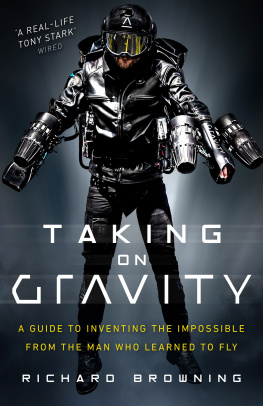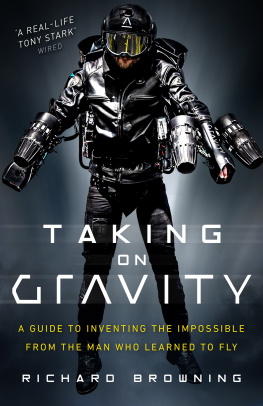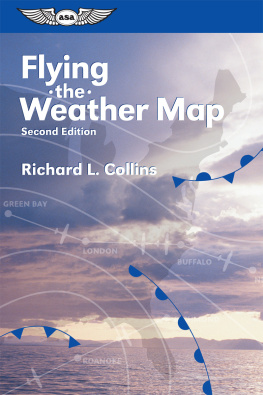Richard Browning
TAKING ON GRAVITY
A Guide to Inventing the Impossible from the Man Who Learned to Fly

TRANSWORLD
UK | USA | Canada | Ireland | Australia
New Zealand | India | South Africa
Transworld is part of the Penguin Random House group of companies whose addresses can be found at global.penguinrandomhouse.com.

First published in Great Britain in 2020 by Bantam Press
Copyright Richard Browning 2020
The moral right of the author has been asserted
Cover photography: Rich Cooper/COAP Media
Every effort has been made to obtain the necessary permissions with reference to copyright material, both illustrative and quoted. We apologize for any omissions in this respect and will be pleased to make the appropriate acknowledgements in any future edition.
ISBN: 978-1-473-56208-0
This ebook is copyright material and must not be copied, reproduced, transferred, distributed, leased, licensed or publicly performed or used in any way except as specifically permitted in writing by the publishers, as allowed under the terms and conditions under which it was purchased or as strictly permitted by applicable copyright law. Any unauthorized distribution or use of this text may be a direct infringement of the authors and publishers rights and those responsible may be liable in law accordingly.
This book is dedicated to my mother Sue for being there, my wife Debbie for believing in me, and to the memory of Michael, my father.
Everything we have done while building Gravity embodies his creativity, passion and spirit.
Introduction
Location: a farmyard in Wiltshire.
Click.
The engines switch into life. I glance up at the data flashing across the inside of my visor. One, two, three, four five! Every jet turbine strapped to my body is operational, accelerating towards 10,000 rpm, 20,000 rpm, then 30,000 rpm before levelling out to idle. The familiar smell of jet exhaust fills the air around me. A growling, roaring sound, like an industrial blowtorch, begins to build, louder and louder until eventually what sounds like an angry hurricane swirls around me.
Im about to fly.
Theres a visceral sense of chest-bashing chaos. Im connected to, and almost enmeshed with, two engines on each arm with another affixed to my back. Their combined power exceeding 1,000 horsepower more than a Formula One car. With my weight of 75 kilos, I have a greater power-to-weight ratio than all known fighter jets. But Ive tamed that power. I reassure myself that everything is under my control.
Arms to my side, the force is directed downwards and builds beneath me. I feel the fearsome roar around my legs, my stomach and my chest. And then
Calm.
The noise and blast growl on, but Im suddenly cocooned within a bubble in which I hear only a gentle rush of air. The sound feels distant, though I know Im in the eye of a storm, and soon I lift, the upward motion starting in the balls of my feet, my weight seemingly melting away until eventually my toes drift effortlessly into the air, inch by inch and then foot by foot to a height of several metres, the thrust commanded by a throttle trigger in my right hand. My body moves ever upwards. To arrest this upward momentum I flare my arms out instinctively. To descend, I lift them even more, redirecting the thrust away from the ground, waiting for gravity to gently work its magic.
Im in control of a flying machine, able to move at will, with the potential to fly in any direction at speeds of 100 mph to altitudes of thousands of feet if I felt like shortening my life expectancy considerably, that is. Ive achieved what most people can only dream about: I can soar above the ground like a bird, outside of a plane, helicopter, hot air balloon or hang glider. It is an incredibly liberating experience.
In fact the sensation is euphoric. Theres a feeling of unlimited freedom. I have complete 360-degree mobility; Im able to launch myself in any direction. The motion is so exhilarating that if Ive been flying throughout the day, when I eventually unclip out of the suit and walk around like everybody else, my movements seem limited, as if Ive been shackled to some unseen object at the ankles. I might want to head towards my car, or cross the road, and the first instinct is to fly directly there, until I remember that physics and evolution have put restrictive rules in place. Walking feels heavy, cumbersome. I suppose the sensation isnt too dissimilar to when a person has been skiing or cycling all day. To suddenly have to move around on foot feels clunky and slow. But when in the air its dreamlike, Im able to drift away like a bird, as if I were in a flow state, oblivious to the constraints of gravity. Its pure and utter joy.
Sometimes explaining the psychological rush associated with both designing and using the suit can be strange. People have, of course, questioned me, certainly in the beginning after we launched publicly. They say, Youve invented a jet suit? But why? Which is a fair enough question: my journey has certainly been unconventional, having departed from a well-paid and stable position in the energy industry in order to pursue an idea that has fascinated and inspired mankind for centuries, from ancient Greeces mythological figures to a whos who of creative minds, including Leonardo da Vinci, the Montgolfier brothers and Elon Musk the idea that a person can fly among the birds, or to the stars, with or without wings, achieving true freedom. Fulfilling this dream has drawn deeply on my reserves of perseverance, innovation and ambition, but whenever I drift ever upwards in the jet suit, my flight gathering altitude and velocity, the world racing by below, in what is a blissful sensation, the effort seems entirely worth it.
The feeling of flight is like no other.
So who wants to have a go?
Richard Browning
Salisbury, 2019
1
The Tony-stark-In-the-cave Moment
Or, How to Get That New Idea Off the Ground
I was an ordinary bloke, working an ordinary job, with an extraordinary idea.
I was deeply intrigued by the fanciful idea of being able to fly like a bird, without the aid of a plane or helicopter. But not only did I want to fly, I also wanted to reshape how man viewed the concept of flying by heavily leaning on the brain and body: the idea that our neuromuscular circuitry, which has been hardwired to walking, or running, might be reprogrammed to operate comfortably while flying with the help of some power.
Prior to inventing a fully functioning jet suit capable of reaching speeds of 100 mph and generating more horsepower than a Bugatti Veyron, I was a Royal Marines Reservist for several years and became fully immersed in the belief that the human body and brain could push beyond what was believed possible. Id crashed through what Id perceived to be my personal limits to pass the Commando Course and attain the coveted green beret. In ultra-marathon competitions I went even further, running greater distances than I ever thought I was capable of, while watching a field of athletes pushing themselves in the same way.
Having eventually left the Royal Marines when the first of my two sons was born, I then replaced the military thrashings with another strenuous pastime: an obsession with callisthenics. This is a style of bodyweight exercise perfected by gymnasts and free runners, not to mention a number of highly skilled athletes in other disciplines, the kind you might see performing at Cirque du Soleil. My interest in the sport began as a lunchtime escape to the gym. I wanted to continue to explore the bodys limits in terms of strength and control. I used my physique in an aggressive way at the gym, building the core strength and muscular control to execute a range of movements. Along with handstand dips and muscle-ups, I was learning how to hold my arms in two gymnastics rings, before suspending my rigid form in a horizontal position, my body held in place with muscular strength alone, a feat gymnasts call the Maltese Cross not that mine was anywhere near the technical proficiency of a proper gymnast. I later learned how to roll up from a crouched position into a handstand and perform planche planks, a tricky position where a persons vertically straightened arms hold the body parallel to the ground like a suspended press-up.















